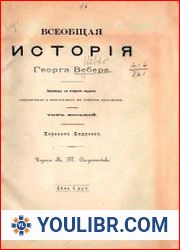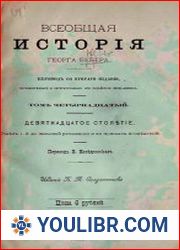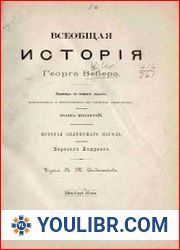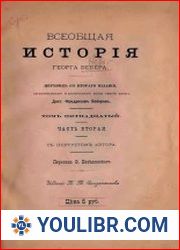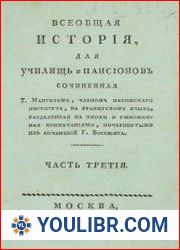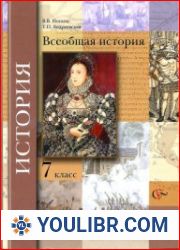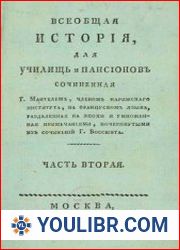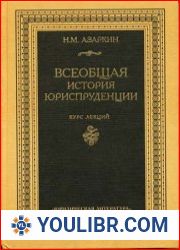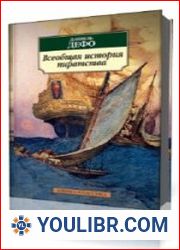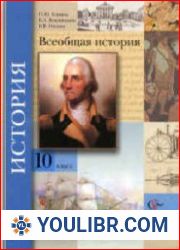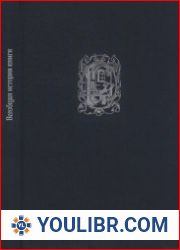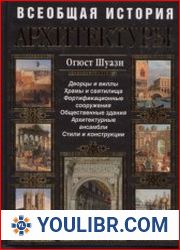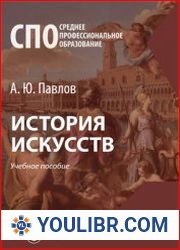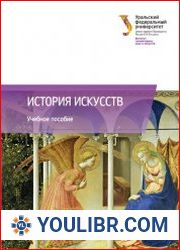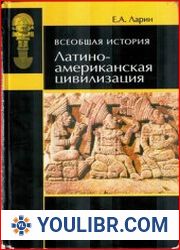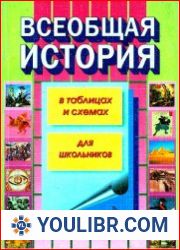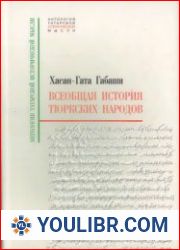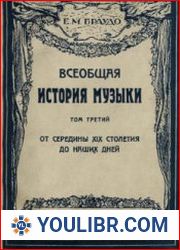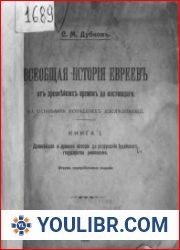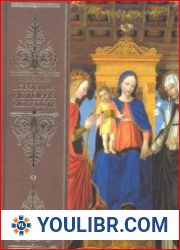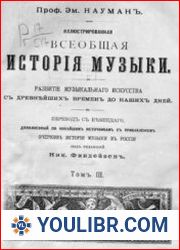
BOOKS - CULTURE AND ARTS - Всеобщая история искусств. В 3 томах...

Всеобщая история искусств. В 3 томах
The author was faced with the task of creating such an art history that could serve as an introduction to the study of art. The pedagogical experience of the author convinced him that the study of art history is fruitful only when acquaintance with monuments and masters, memorization of names and dates is accompanied by successes in understanding art, the development of artistic taste. This confidence of the author determined the construction of his book. She turns not only to the reader's mental abilities and to his memory, but also to his aesthetic feeling, to his critical instinct. It should be read not only in order to assimilate the general provisions expressed in it and memorize the information it provides, but primarily in order to understand the main ways of the historical development of the artistic culture of mankind and learn to understand appreciate old and modern art.
Подробное описание сюжета книги 'Всеобщая история искусств В 3 томах'. Введение: Книга «Всеобъемлющая история искусств в 3 томах» представляет собой всеобъемлющее руководство по эволюции искусства на протяжении всей истории человечества, написанное известным историком искусства. Педагогический опыт автора показал, что изучение истории искусства наиболее продуктивно, когда сопровождается пониманием развития художественного вкуса, а не простым запоминанием имен и дат. Поэтому эта книга призвана не только информировать читателей об основных вехах в истории искусства, но и культивировать их эстетические чувствительности и навыки критического мышления. Первый том: Древнее искусство Первый том начинается с самых ранних известных примеров искусства, относящихся к доисторическим временам, и прослеживает развитие искусства через древние цивилизации Египта, Греции и Рима. Автор выделяет уникальные особенности каждой культуры, такие как использование иероглифики в египетском искусстве и идеализированные изображения человеческой формы в греческом и римском искусстве. وصف مفصل لحبكة كتاب «التاريخ العام للفن في 3 مجلدات». المقدمة: كتاب «تاريخ شامل للفن في 3 مجلدات» هو دليل شامل لتطور الفن عبر التاريخ البشري، كتبه مؤرخ فني مشهور. أظهرت التجربة التربوية للمؤلف أن دراسة تاريخ الفن تكون أكثر إنتاجية عندما تكون مصحوبة بفهم لتطور الذوق الفني، وليس مجرد تذكر الأسماء والتواريخ. لذلك، لا يهدف هذا الكتاب إلى إطلاع القراء على المعالم الرئيسية في تاريخ الفن فحسب، بل يهدف أيضًا إلى تنمية حساسياتهم الجمالية ومهاراتهم في التفكير النقدي. المجلد الأول: المجلد الأول للفن القديم يبدأ بأقدم الأمثلة المعروفة للفن الذي يعود تاريخه إلى عصور ما قبل التاريخ ويتتبع تطور الفن من خلال الحضارات القديمة في مصر واليونان وروما. يسلط المؤلف الضوء على السمات الفريدة لكل ثقافة، مثل استخدام الهيروغليفية في الفن المصري والتصوير المثالي للشكل البشري في الفن اليوناني والروماني. '3 권의 일반 예술사'책의 음모에 대한 자세한 설명. 소개: "3 권의 종합 예술사" 라는 책은 유명한 예술가가 쓴 인류 역사 전반에 걸친 예술의 진화에 대한 포괄적 인 가이드입니다. 저자의 교육 경험에 따르면 미술사 연구는 단순히 이름과 날짜를 기억하는 것이 아니라 예술적 취향의 발전에 대한 이해를 동반 할 때 가장 생산적입니다. 따라서이 책은 독자들에게 미술사의 주요 이정표를 알려줄뿐만 아니라 미적 감도와 비판적 사고 기술을 배양하기위한 것입니다. 1 권: 고대 미술 1 권은 선사 시대로 거슬러 올라가는 최초의 알려진 예술 사례로 시작하여 이집트, 그리스 및 로마의 고대 문명을 통해 예술의 발전을 추적합니다. 저자는 이집트 예술에서 상형 문자를 사용하고 그리스와 로마 예술에서 인간 형태의 이상적인 묘사와 같은 각 문화의 독특한 특징을 강조합니다. Description détaillée de l'histoire du livre « Histoire universelle des arts en 3 volumes ». Introduction : livre Une histoire complète de l'art en 3 volumes est un guide complet sur l'évolution de l'art à travers l'histoire de l'humanité, écrit par un historien de l'art célèbre. L'expérience pédagogique de l'auteur a montré que l'étude de l'histoire de l'art est la plus productive quand elle s'accompagne d'une compréhension du développement du goût artistique plutôt que d'une simple mémorisation des noms et des dates. C'est pourquoi ce livre vise non seulement à informer les lecteurs des principaux jalons de l'histoire de l'art, mais aussi à cultiver leurs sensibilités esthétiques et leur savoir-faire critique. Premier volume : Art ancien premier volume commence par les premiers exemples connus d'art datant de l'époque préhistorique et retrace le développement de l'art à travers les civilisations antiques d'Egypte, de Grèce et de Rome. L'auteur met en évidence les caractéristiques uniques de chaque culture, telles que l'utilisation des hiéroglyphes dans l'art égyptien et des images idéalisées de la forme humaine dans l'art grec et romain. תיאור מפורט | של עלילת הספר ”היסטוריה כללית של האמנות בכרכים 3”. מבוא: הספר A Compressive History of Art in 3 Volums הוא מדריך מקיף להתפתחות האמנות בהיסטוריה האנושית, שנכתב על ידי היסטוריון אמנות ידוע. החוויה הפדגוגית של המחבר הוכיחה כי חקר תולדות האמנות הוא פורה ביותר כאשר מלווה בהבנה של התפתחות הטעם האמנותי, ולא רק בזכירת שמות ותאריכים. לפיכך, ספר זה נועד לא רק ליידע את הקוראים על אבני דרך מרכזיות בתולדות האמנות, אלא גם לטפח את רגישותם האסתטית ואת מיומנויות החשיבה הביקורתיות שלהם. כרך ראשון: כרך ראשון לאמנות עתיקה (Ancient Art Volume 1) מתחיל בדוגמאות הראשונות הידועות של אמנות מתקופה פרהיסטורית ועוקב אחר התפתחות האמנות דרך הציוויליזציות העתיקות של מצרים, יוון ורומא. המחבר מדגיש את המאפיינים הייחודיים של כל תרבות, כמו השימוש בהירוגליפים באמנות המצרית ותיאורים אידיאליסטיים של צורת האדם באמנות היוונית והרומית. Szczegółowy opis działki książki „Historia ogólna sztuki w 3 tomach”. Wprowadzenie: Książka „Wszechstronna historia sztuki w 3 tomach” jest wszechstronnym przewodnikiem po ewolucji sztuki w całej historii ludzkości, napisana przez znanego historyka sztuki. Doświadczenie pedagogiczne autora pokazało, że badanie historii sztuki jest najbardziej produktywne, gdy towarzyszy mu zrozumienie rozwoju smaku artystycznego, a nie tylko zapamiętywanie nazw i dat. Dlatego książka ta ma na celu nie tylko informowanie czytelników o najważniejszych kamieniach milowych w historii sztuki, ale także pielęgnowanie ich estetycznych wrażliwości i krytycznych umiejętności myślenia. Tom pierwszy: Tom sztuki starożytnej Pierwszy rozpoczyna się od najwcześniejszych znanych przykładów sztuki sięgających czasów prehistorycznych i śledzi rozwój sztuki poprzez starożytne cywilizacje Egiptu, Grecji i Rzymu. Autor podkreśla unikalne cechy każdej kultury, takie jak stosowanie hieroglifów w sztuce egipskiej i wyidealizowane przedstawienia ludzkiej formy w sztuce greckiej i rzymskiej. Long detailed description of the plot for the book 'Всеобщая история искусств В 3 томах'. Introduction: The book "All-embracing History of Arts in 3 Volumes" is a comprehensive guide to the evolution of art throughout human history, written by a renowned art historian. The author's pedagogical experience has shown that studying art history is most productive when it is accompanied by an understanding of the development of artistic taste, rather than simply memorizing names and dates. Therefore, this book is designed not only to inform readers about the major milestones in the history of art, but also to cultivate their aesthetic sensibilities and critical thinking skills. Volume One: Ancient Art The first volume begins with the earliest known examples of art, dating back to prehistoric times, and traces the development of art through the ancient civilizations of Egypt, Greece, and Rome. The author highlights the unique characteristics of each culture, such as the use of hieroglyphics in Egyptian art and the idealized depictions of the human form in Greek and Roman art. Ausführliche Beschreibung der Handlung des Buches „Allgemeine Kunstgeschichte in 3 Bänden“. Einleitung: Das Buch Umfassende Kunstgeschichte in 3 Bänden ist ein umfassender itfaden für die Entwicklung der Kunst in der Geschichte der Menschheit, geschrieben von einem renommierten Kunsthistoriker. Die pädagogische Erfahrung des Autors hat gezeigt, dass das Studium der Kunstgeschichte am produktivsten ist, wenn es von einem Verständnis der Entwicklung des künstlerischen Geschmacks begleitet wird, anstatt sich nur an Namen und Daten zu erinnern. Dieses Buch soll daher nicht nur die ser über die großen Meilensteine der Kunstgeschichte informieren, sondern auch deren ästhetische Befindlichkeiten und kritisches Denkvermögen pflegen. Erster Band: Alte Kunst Der erste Band beginnt mit den frühesten bekannten Kunstbeispielen aus prähistorischer Zeit und zeichnet die Entwicklung der Kunst durch die alten Zivilisationen Ägyptens, Griechenlands und Roms nach. Der Autor hebt die einzigartigen Merkmale jeder Kultur hervor, wie die Verwendung von Hieroglyphen in der ägyptischen Kunst und idealisierte Darstellungen der menschlichen Form in der griechischen und römischen Kunst. Descrizione dettagliata del libro «Storia universale dell'arte In 3 volumi». Introduzione: Il libro «Storia completa dell'arte in 3 volumi» è una guida completa all'evoluzione dell'arte nel corso della storia dell'umanità, scritta da un noto storico dell'arte. L'esperienza didattica dell'autore ha dimostrato che lo studio della storia dell'arte è più produttivo quando si accompagna alla comprensione dello sviluppo del gusto artistico piuttosto che alla semplice memorizzazione di nomi e date. Questo libro non è quindi solo per informare i lettori dei principali punti cardine della storia dell'arte, ma anche per coltivare le loro sensibilità estetiche e le loro abilità di pensiero critico. Primo volume: Arte antica Il primo volume inizia con i primi esempi d'arte conosciuti risalenti alla preistoria e traccia lo sviluppo dell'arte attraverso le antiche civiltà egiziane, greche e romane. L'autore evidenzia le caratteristiche uniche di ogni cultura, come l'uso di geroglifici nell'arte egiziana e immagini idealizzate della forma umana nell'arte greca e romana. Descrição detalhada da História Universal das Artes Em 3 Volumes. Introdução: O livro «História das artes abrangente em 3 volumes» é um guia abrangente sobre a evolução da arte ao longo da história da humanidade, escrito por um conhecido historiador da arte. A experiência pedagógica do autor mostrou que o estudo da história da arte é mais produtivo quando acompanhado pela compreensão do desenvolvimento do gosto artístico, e não pela simples memorização de nomes e datas. Por isso, este livro não só é projetado para informar os leitores sobre os principais aspectos da história da arte, mas também para cultivar suas sensibilidades estéticas e habilidades de pensamento crítico. Primeiro volume: Arte Antiga O primeiro volume começa com os mais antigos exemplos de arte conhecidos da pré-história e traça o desenvolvimento da arte através das civilizações antigas do Egito, Grécia e Roma. O autor destaca as características únicas de cada cultura, como o uso da hieroglítica na arte egípcia e as imagens idealizadas da forma humana na arte grega e romana. Descripción detallada de la trama del libro 'Historia universal del arte En 3 volúmenes'. Introducción: libro «Historia integral del arte en 3 volúmenes» es una guía integral sobre la evolución del arte a lo largo de la historia de la humanidad, escrita por un reconocido historiador del arte. La experiencia pedagógica del autor ha demostrado que el estudio de la historia del arte es lo más productivo cuando se acompaña de la comprensión del desarrollo del gusto artístico y no de la mera memorización de nombres y fechas. Por ello, este libro no solo pretende informar a los lectores de los principales hitos de la historia del arte, sino también cultivar sus sensibilidades estéticas y sus habilidades de pensamiento crítico. Primer volumen: Arte antiguo primer volumen comienza con los primeros ejemplos conocidos de arte que datan de la prehistoria y traza el desarrollo del arte a través de las civilizaciones antiguas de Egipto, Grecia y Roma. autor destaca las características únicas de cada cultura, como el uso de jeroglíficos en el arte egipcio y las imágenes idealizadas de la forma humana en el arte griego y romano. 本のプロットの詳細な説明「3巻の芸術の一般的な歴史」。はじめに:本「3巻の芸術の包括的な歴史」は、有名な美術史家によって書かれた、人間の歴史全体の芸術の進化に関する包括的なガイドです。著者の教育的経験は、単に名前と日付を覚えているのではなく、芸術的な味の発展の理解を伴って、芸術史の研究が最も生産的であることを示しています。したがって、この本は、美術史の主要なマイルストーンを読者に知らせるだけでなく、美的感性と批判的思考力を養うことを目的としています。Volume One: Ancient Art Volume先史時代にさかのぼる最も初期の既知のアートの例から始まり、エジプト、ギリシャ、ローマの古代文明を通してアートの発展をたどる。エジプト美術における象形文字の使用や、ギリシア美術やローマ美術における人間の姿を理想化した描写など、それぞれの文化の特徴を強調している。 "3 ciltlik Genel Sanat Tarihi" kitabının konusu hakkında ayrıntılı açıklama. Giriş: "A Comprehensive History of Art in 3 Volumes" kitabı, ünlü bir sanat tarihçisi tarafından yazılan, insanlık tarihi boyunca sanatın evrimine dair kapsamlı bir kılavuzdur. Yazarın pedagojik deneyimi, sanat tarihi çalışmasının, sadece isimleri ve tarihleri hatırlamakla kalmayıp, sanatsal zevkin gelişiminin bir anlayışı eşliğinde en verimli olduğunu göstermiştir. Bu nedenle, bu kitap sadece okuyucuları sanat tarihindeki önemli kilometre taşları hakkında bilgilendirmeyi değil, aynı zamanda estetik hassasiyetlerini ve eleştirel düşünme becerilerini geliştirmeyi amaçlamaktadır. Birinci Cilt: Antik Sanat Birinci Cilt, tarih öncesi zamanlara dayanan bilinen en eski sanat örnekleriyle başlar ve Mısır, Yunanistan ve Roma'nın eski uygarlıkları boyunca sanatın gelişimini izler. Yazar, Mısır sanatında hiyerogliflerin kullanımı ve Yunan ve Roma sanatında insan formunun idealize edilmiş tasvirleri gibi her kültürün benzersiz özelliklerini vurgulamaktadır. 「通用藝術史三卷」的詳細情節描述。導言:《三卷綜合藝術史》一書是著名藝術史學家撰寫的關於人類歷史上藝術發展的綜合指南。作者的教學經驗表明,當伴隨著對藝術品味發展的理解而不是簡單地記住名字和日期時,對藝術史的研究最有成效。因此,這本書不僅旨在使讀者了解藝術史上的主要裏程碑,而且還旨在培養他們的審美敏感性和批判性思維能力。第一卷:古代藝術第一卷始於史前時期最早的已知藝術實例,並通過埃及,希臘和羅馬的古代文明追溯了藝術的發展。作者強調了每種文化的獨特特征,例如在埃及藝術中使用象形文字,以及在希臘和羅馬藝術中對人類形式的理想化描繪。
تنزيل ملف pdf تاريخ الفن العام. في 3 مجلدات скачать файл PDF Всеобщая история искусств. В 3 томах download pdf file Всеобщая история искусств. В 3 томах PDF-Datei herunterladen Allgemeine Kunstgeschichte. In 3 Bänden להוריד קובץ PDF תולדות האמנות הכללית. בכרכים 3 télécharger le fichier pdf Histoire universelle des arts. En 3 volumes descargar archivo pdf Historia Universal del Arte. En 3 volúmenes pdf 파일 다운로드 PDFファイルをダウンロード 総合美術史。全3巻 descarregar ficheiro pdf História universal das artes. Em 3 volumes pdf dosyasını indir Genel Sanat Tarihi. 3 ciltte 下载 pdf 文件 通用藝術史。3卷
pobierz plik pdf Historia sztuki. W 3 tomach download pdf file Scarica il file pdf Storia universale dell'arte. In 3 volumi
El autor tenía ante sí la tarea de crear una historia del arte que pudiera servir también de introducción al estudio del arte. La experiencia pedagógica del autor le convenció de que el estudio de la historia del arte sólo fructifica cuando la familiaridad con monumentos y maestros, la memorización de nombres y fechas se acompaña de éxitos en la tarea de entender el arte, y el desarrollo del gusto artístico. Esta confianza del autor determinó la construcción de su libro. Aborda no solo la capacidad mental del lector y su memoria, sino también su sentido estético, su sensibilidad crítica. Debe leerse no sólo para asimilar las disposiciones generales que en ella se exponen y para memorizar la información que comunica, sino sobre todo para comprender las principales vías de desarrollo histórico de la cultura artística de la humanidad y aprender a comprender y valorar el arte antiguo y contemporáneo.
The author was faced with the task of creating such an art history that could serve as an introduction to the study of art. The pedagogical experience of the author convinced him that the study of art history is fruitful only when acquaintance with monuments and masters, memorization of names and dates is accompanied by successes in understanding art, the development of artistic taste. This confidence of the author determined the construction of his book. She turns not only to the reader's mental abilities and to his memory, but also to his aesthetic feeling, to his critical instinct. It should be read not only in order to assimilate the general provisions expressed in it and memorize the information it provides, but primarily in order to understand the main ways of the historical development of the artistic culture of mankind and learn to understand appreciate old and modern art.
Der Autor stand vor der Aufgabe, eine Kunstgeschichte zu schaffen, die auch als Einführung in das Kunststudium dienen konnte. Die pädagogische Erfahrung des Autors überzeugte ihn, dass das Studium der Kunstgeschichte nur dann fruchtbar ist, wenn die Bekanntschaft mit Denkmälern und Meistern, das Auswendiglernen von Namen und Daten von Erfolgen beim Verständnis der Kunst und der Entwicklung des künstlerischen Geschmacks begleitet wird. Dieses Vertrauen des Autors bestimmte die Konstruktion seines Buches. Sie thematisiert nicht nur die geistigen Fähigkeiten des Lesers und sein Gedächtnis, sondern auch seinen ästhetischen Sinn, sein kritisches Gespür. Es sollte nicht nur gelesen werden, um die darin geäußerten allgemeinen Leitsätze zu verinnerlichen und die von ihm mitgeteilten Informationen auswendig zu lernen, sondern vor allem, um sich die grundlegenden Wege der historischen Entwicklung der künstlerischen Kultur der Menschheit klarzumachen und zu lernen, die alte und die moderne Kunst zu verstehen und zu schätzen.
L'auteur avait pour tâche de créer une telle histoire de l'art qui pourrait servir et d'introduction à l'étude de l'art. L'expérience pédagogique de l'auteur l'a convaincu que l'étude de l'histoire des arts n'est fructueuse que lorsque la connaissance des monuments et des maîtres, la mémorisation des noms et des dates s'accompagne de succès dans la compréhension de l'art, le développement du goût artistique. Cette confiance de l'auteur a déterminé la construction de son livre. Elle s'adresse non seulement aux capacités mentales du lecteur et à sa mémoire, mais aussi à son sens esthétique, à son sens critique. Elle doit être lue non seulement pour assimiler les dispositions générales qu'elle contient et pour apprendre les informations qu'elle rapporte, mais surtout pour comprendre les principales voies de développement historique de la culture artistique de l'humanité et apprendre à comprendre et à apprécier l'art ancien et moderne.
Перед автором стояла задача создания такой истории искусств, которая могла бы служить и введением в изучение искусства. Педагогический опыт автора убедил его, что изучение истории искусств плодотворно лишь тогда, когда знакомство с памятниками и мастерами, запоминание имен и дат сопровождается успехами в деле понимания искусства, развитием художественного вкуса. Эта уверенность автора определила построение его книги. Она обращается не только к умственным способностям читателя и к его памяти, но и к его эстетическому чувству, к его критическому чутью. Ее следует читать не только для того, чтобы усвоить высказанные в ней общие положения и заучить сообщаемые ею сведения, но в первую очередь для того, чтобы уяснить себе основные пути исторического развития художественной культуры человечества и научиться понимать и ценить старое и современное искусство.
L'autore aveva il compito di creare una storia dell'arte che potesse servire anche come introduzione allo studio dell'arte. L'esperienza didattica dell'autore lo convinse che lo studio della storia dell'arte era efficace solo quando conoscere monumenti e maestri, ricordare nomi e date è accompagnato da successi nella comprensione dell'arte e nello sviluppo del gusto artistico. Questa fiducia dell'autore ha determinato la costruzione del suo libro. Si rivolge non solo alle capacità mentali del lettore e alla sua memoria, ma anche al suo senso estetico, al suo istinto critico. Deve essere letta non solo per imparare le disposizioni generali espresse in esso, ma soprattutto per imparare a comprendere e valorizzare l'arte vecchia e contemporanea.
O autor tinha o desafio de criar uma história de arte que pudesse servir de introdução à exploração da arte. A experiência pedagógica do autor convenceu-o de que o estudo da história da arte só é frutífero quando conhecer monumentos e mestres, memorizar nomes e datas é acompanhado de sucesso na compreensão da arte e desenvolver o gosto artístico. Essa confiança do autor definiu a construção do seu livro. Ela não se dirige apenas às habilidades mentais do leitor e à sua memória, mas também ao seu sentimento estético, ao seu instinto crítico. Ela não deve ser lida apenas para aprender as suas posições gerais e ensinar as suas informações, mas principalmente para aprender quais são os principais caminhos para o desenvolvimento histórico da cultura artística da humanidade e aprender a compreender e apreciar as artes antigas e modernas.
El autor tenía ante sí la tarea de crear una historia del arte que pudiera servir también de introducción al estudio del arte. La experiencia pedagógica del autor le convenció de que el estudio de la historia del arte sólo fructifica cuando la familiaridad con monumentos y maestros, la memorización de nombres y fechas se acompaña de éxitos en la tarea de entender el arte, y el desarrollo del gusto artístico. Esta confianza del autor determinó la construcción de su libro. Aborda no solo la capacidad mental del lector y su memoria, sino también su sentido estético, su sensibilidad crítica. Debe leerse no sólo para asimilar las disposiciones generales que en ella se exponen y para memorizar la información que comunica, sino sobre todo para comprender las principales vías de desarrollo histórico de la cultura artística de la humanidad y aprender a comprender y valorar el arte antiguo y contemporáneo.
The author was faced with the task of creating such an art history that could serve as an introduction to the study of art. The pedagogical experience of the author convinced him that the study of art history is fruitful only when acquaintance with monuments and masters, memorization of names and dates is accompanied by successes in understanding art, the development of artistic taste. This confidence of the author determined the construction of his book. She turns not only to the reader's mental abilities and to his memory, but also to his aesthetic feeling, to his critical instinct. It should be read not only in order to assimilate the general provisions expressed in it and memorize the information it provides, but primarily in order to understand the main ways of the historical development of the artistic culture of mankind and learn to understand appreciate old and modern art.
Der Autor stand vor der Aufgabe, eine Kunstgeschichte zu schaffen, die auch als Einführung in das Kunststudium dienen konnte. Die pädagogische Erfahrung des Autors überzeugte ihn, dass das Studium der Kunstgeschichte nur dann fruchtbar ist, wenn die Bekanntschaft mit Denkmälern und Meistern, das Auswendiglernen von Namen und Daten von Erfolgen beim Verständnis der Kunst und der Entwicklung des künstlerischen Geschmacks begleitet wird. Dieses Vertrauen des Autors bestimmte die Konstruktion seines Buches. Sie thematisiert nicht nur die geistigen Fähigkeiten des Lesers und sein Gedächtnis, sondern auch seinen ästhetischen Sinn, sein kritisches Gespür. Es sollte nicht nur gelesen werden, um die darin geäußerten allgemeinen Leitsätze zu verinnerlichen und die von ihm mitgeteilten Informationen auswendig zu lernen, sondern vor allem, um sich die grundlegenden Wege der historischen Entwicklung der künstlerischen Kultur der Menschheit klarzumachen und zu lernen, die alte und die moderne Kunst zu verstehen und zu schätzen.
L'auteur avait pour tâche de créer une telle histoire de l'art qui pourrait servir et d'introduction à l'étude de l'art. L'expérience pédagogique de l'auteur l'a convaincu que l'étude de l'histoire des arts n'est fructueuse que lorsque la connaissance des monuments et des maîtres, la mémorisation des noms et des dates s'accompagne de succès dans la compréhension de l'art, le développement du goût artistique. Cette confiance de l'auteur a déterminé la construction de son livre. Elle s'adresse non seulement aux capacités mentales du lecteur et à sa mémoire, mais aussi à son sens esthétique, à son sens critique. Elle doit être lue non seulement pour assimiler les dispositions générales qu'elle contient et pour apprendre les informations qu'elle rapporte, mais surtout pour comprendre les principales voies de développement historique de la culture artistique de l'humanité et apprendre à comprendre et à apprécier l'art ancien et moderne.
Перед автором стояла задача создания такой истории искусств, которая могла бы служить и введением в изучение искусства. Педагогический опыт автора убедил его, что изучение истории искусств плодотворно лишь тогда, когда знакомство с памятниками и мастерами, запоминание имен и дат сопровождается успехами в деле понимания искусства, развитием художественного вкуса. Эта уверенность автора определила построение его книги. Она обращается не только к умственным способностям читателя и к его памяти, но и к его эстетическому чувству, к его критическому чутью. Ее следует читать не только для того, чтобы усвоить высказанные в ней общие положения и заучить сообщаемые ею сведения, но в первую очередь для того, чтобы уяснить себе основные пути исторического развития художественной культуры человечества и научиться понимать и ценить старое и современное искусство.
L'autore aveva il compito di creare una storia dell'arte che potesse servire anche come introduzione allo studio dell'arte. L'esperienza didattica dell'autore lo convinse che lo studio della storia dell'arte era efficace solo quando conoscere monumenti e maestri, ricordare nomi e date è accompagnato da successi nella comprensione dell'arte e nello sviluppo del gusto artistico. Questa fiducia dell'autore ha determinato la costruzione del suo libro. Si rivolge non solo alle capacità mentali del lettore e alla sua memoria, ma anche al suo senso estetico, al suo istinto critico. Deve essere letta non solo per imparare le disposizioni generali espresse in esso, ma soprattutto per imparare a comprendere e valorizzare l'arte vecchia e contemporanea.
O autor tinha o desafio de criar uma história de arte que pudesse servir de introdução à exploração da arte. A experiência pedagógica do autor convenceu-o de que o estudo da história da arte só é frutífero quando conhecer monumentos e mestres, memorizar nomes e datas é acompanhado de sucesso na compreensão da arte e desenvolver o gosto artístico. Essa confiança do autor definiu a construção do seu livro. Ela não se dirige apenas às habilidades mentais do leitor e à sua memória, mas também ao seu sentimento estético, ao seu instinto crítico. Ela não deve ser lida apenas para aprender as suas posições gerais e ensinar as suas informações, mas principalmente para aprender quais são os principais caminhos para o desenvolvimento histórico da cultura artística da humanidade e aprender a compreender e apreciar as artes antigas e modernas.











